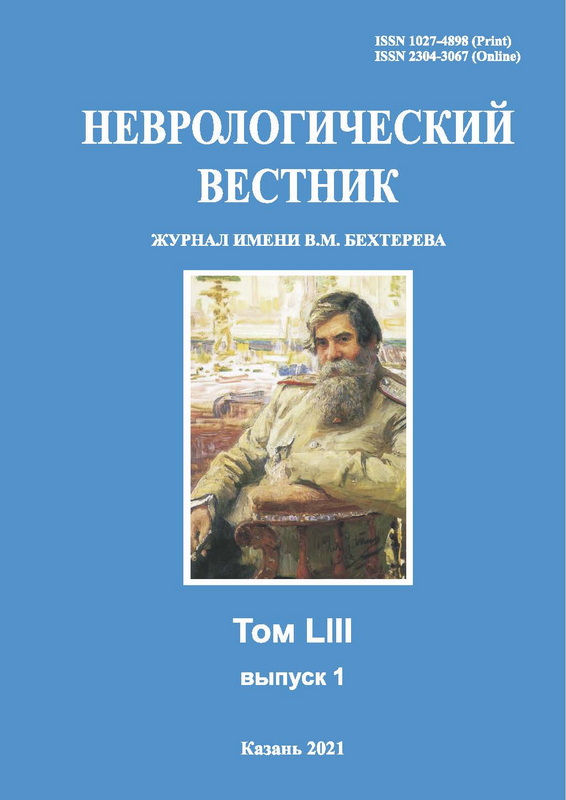О перманентной диагностике в детской психиатрии
- Авторы: Пашковский В.Э.1,2
-
Учреждения:
- Национальный медицинский исследовательский центр психиатрии и неврологии им. В.М. Бехтерева
- Санкт-Петербургский государственный университет
- Выпуск: Том LIII, № 1 (2021)
- Страницы: 48-51
- Раздел: Дискуссии
- Статья получена: 26.12.2020
- Статья одобрена: 01.02.2021
- Статья опубликована: 20.04.2021
- URL: https://journals.eco-vector.com/1027-4898/article/view/56989
- DOI: https://doi.org/10.17816/nb56989
- ID: 56989
Цитировать
Полный текст
Аннотация
В статье проанализирована проблема диагностики в детской психиатрии. Показано, что ошибки в ней во многом связаны с особенностями развития на ранних этапах онтогенеза. Освещена необходимость учитывать в диагностическом процессе теоретические положения П.П. Блонского, Л.С. Выготского, Д.Б. Эльконина о кризах детского и подросткового возраста и В.В. Ковалёва об уровнях нервно-психического реагирования. В статье показано, что аритмия раннего развития сказывается на диагностике такой патологии, как расстройство аутистического спектра. Подчёркнуто, что типичную в детском возрасте клиническую диффузность расстройства недооценивают. Констатировано, что гетерохрония развития в детском возрасте настоятельно требует перехода от нозоцентрированной к риск-центрированной диагностике.
Ключевые слова
Полный текст
Об авторах
Владимир Эдуардович Пашковский
Национальный медицинский исследовательский центр психиатрии и неврологии им. В.М. Бехтерева; Санкт-Петербургский государственный университет
Автор, ответственный за переписку.
Email: pashvladimir@yandex.ru
ORCID iD: 0000-0002-9596-3453
SPIN-код: 6832-0019
Scopus Author ID: 6503993999
ResearcherId: ABE-1655-2020
Доктор медицинских наук, доцент, ведущий научный сотрудник научно-организационного отделения ФГБУ «Национальный медицинский исследовательский центр психиатрии и неврологии им. В.М. Бехтерева» Минздрава России, профессор кафедры психиатрии и наркологии Санкт-Петербургского государственного университета
Россия, 192019, г. Санкт-Петербург, ул. Бехтерева, 3; 199034, г. Санкт-Петербург, Университетская наб., 7–9Список литературы
- Венар Ч., Кериг П. Психопатология развития детского и подросткового возраста. Под ред. А.А. Алексеева. Пер. с англ. СПб.: Прайм-ЕВРОЗНАК. 2004; 384 с. [Venar Ch., Kerig P. Psikhopatologiya razvitiya detskogo i podrostkovogo vozrasta. Pod red. A.A. Alekseyeva. Per. s angl. SPb.: Praym-EVROZNAK. 2004; 384 р. (In Russ.)]
- Ковалёв В.В. Семиотика и диагностика психических заболеваний у детей и подростков. М.: Медицина. 1985; 286 c. [Kovalev V.V. Semiotika i diagnostika psikhicheskikh zabolevaniy u detey i podrostkov. M.: Meditsina. 1985; 286 р. (In Russ.)]
- Исаев Д.Н. Умственная отсталость у детей и подростков. Руководство. СПб.: Речь. 2003; 391 с. [Isayev D.N. Umstvennaya otstalost’ u detey i podrostkov. Rukovodstvo. SPb.: Rech’. 2003; 391 р. (In Russ.)]
- Блонский П.П. Педология. Учебник для высших педагогических учебных заведений. М.: Гос. учеб. педагог. изд. 1936; 336 с. [Blonskiy P.P. Pedologiya. Uchebnik dlya vysshikh pedagogicheskikh uchebnyh zavedeniy. M.: Gos. ucheb. pedagog. izd. 1936; 336 р. (In Russ.)]
- Выготский Л.С. Вопросы детской (возрастной) психологии. Собрание сочинений. М.: Педагогика. 1984; 4: 243–403. [Vygotskiy L.S. Voprosy detskoy (vozrastnoy) psikhologii. Sobraniye sochineniy. M.: Pedagogika. 1984; 4: 243–403. (In Russ.)]
- Эльконин Д.Б. К проблеме периодизации психического развития в детском возрасте. Вопр. психол. 1971; (4): 39–51. [Elkonin D.B. On the problem of periodization of mental development in childhood. Voprosy psikhologii. 1971; (4): 39–51. (In Russ.)]
- Дейниченко Л.Б. Исследование возрастных кризисов детства в отечественной психологии. В сб.: Актуальные проблемы теории и практики психологических, психолого-педагогических и лингводидактических исследований. Сборник материалов Международной научно-практической конференции. В 2 т. М.: Московский государственный областной университет. 2019; 2: 45–52. [Deynichenko L.B. Issledovaniye vozrastnykh krizisov detstva v otechestvennoy psikhologii. In: Aktual’n•yye problemy teorii i praktiki psikhologicheskikh, psikhologo-pedagogicheskikh i lingvodidakticheskikh issledovaniy. Sbornik materialov Mezhdunarodnoy nauchno-prakticheskoy konferentsii v 2 tomakh. M.: Moskovskiy gosudarstvennyy oblastnoy universitet. 2019; 2: 45–52. (In Russ.)]
- Gillberg C. The ESSENCE in child psychiatry: Early symptomatic syndromes eliciting neurodevelopmental clinical examinations. Res. Dev. Disabil. 2010; 31 (6): 1543–1551. doi: 10.1016/j.ridd.2010.06.002. PMID: 20634041.
- Evans B. The foundations of autism: the law concerning psychotic, schizophrenic, and autistic children in 1950s and 1960s britain. Bull. Hist. Med. 2014; 88 (2): 253–285. doi: 10.1353/bhm.2014.0033.
- Zwaigenbaum L., Bauman M.L., Choueiri R. et al. Early intervention for children with autism spectrum disorder under 3 years of age: Recommendations for practice and research. Pediatrics. 2015; 136 (1): S60–S81. doi: 10.1542/peds.2014-3667E. PMID: 26430170.
- Kleinman J.M., Ventola P.E., Pandey J. et al. Diagnostic stability in very young children with an autism spectrum disorder. J. Autism Dev. Disord. 2008; 38 (4): 606–615. doi: 10.1007/s10803-007-0427-8.
- Симашкова Н.В., Иванов М.В., Макушкин Е.В. и др. Скрининг риска возникновения нарушений психического развития у детей раннего возраста (данные по 9 регионам России в 2017–2019 гг.). Ж. неврол. и психиатрии им. С.С. Корсакова. 2020; 120 (11): 79–86. [Simashkova N.V., Ivanov M.V., Makushkin E.V. et al. Screening of the risk of mental and developmental disorders in children of early age in the Russian population (2017–2019). Zhurnal nevrologii i psikhiatrii im. S.S. Korsakova. 2020; 120 (11): 79–86. (In Russ.)] doi: 10.17116/jnevro202012011179.
- Sutera S., Pandey J., Esser E.L. et al. Predictors of optimal outcome in toddlers diagnosed with autism spectrum disorders. J. Autism Dev. Disord. 2007; 37 (1): 98–107. doi: 10.1007/s10803-006-0340-6.
- Turner L.M., Stone W.L. Variability in outcome for children with an ASD diagnosis at age 2. J. Child Psychol. Psychiatry. 2007; 48 (8): 793–802. doi: 10.1111/j.1469-7610.2007.01744.x. PMID: 17683451.
- Maddox B.B., Brodkin E.S., Calkins M.E. et al. The Accuracy of the ADOS-2 in identifying autism among adults with complex psychiatric conditions. J. Autism Dev. Disord. 2017; 47 (9): 2703–2709. doi: 10.1007/s10803-017-3188-z. PMID: 28589494. PMCID: PMC5813679.
- Kaufman N.K. Rethinking “gold standards” and “best practices” in the assessment of autism. Appl. Neuropsychol. Child. 2020, Aug. 27; 1–12. doi: 10.1080/21622965.2020.1809414. PMID: 32847428.
Дополнительные файлы







